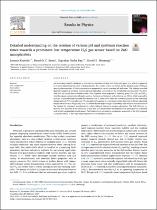 ResearchSpace
ResearchSpace
Detailed understanding on the relation of various pH and synthesis reaction times towards a prominent low temperature H2S gas sensor based on ZnO nanoplatelets
JavaScript is disabled for your browser. Some features of this site may not work without it.
- ResearchSpace
- →
- Research Publications/Outputs
- →
- Journal Articles
- →
- View Item
| dc.contributor.author |
Kortidis, Ioannis

|
|
| dc.contributor.author |
Swart, HC

|
|
| dc.contributor.author |
Ray, Suprakas S

|
|
| dc.contributor.author |
Motaung, David E

|
|
| dc.date.accessioned | 2019-03-27T09:27:53Z | |
| dc.date.available | 2019-03-27T09:27:53Z | |
| dc.date.issued | 2019-03 | |
| dc.identifier.citation | Kortidis, I. et al. 2019. Detailed understanding on the relation of various pH and synthesis reaction times towards a prominent low temperature H2S gas sensor based on ZnO nanoplatelets. Results in Physics, vol. 12: 2189-2201 | en_US |
| dc.identifier.issn | 2211-3797 | |
| dc.identifier.uri | https://doi.org/10.1016/j.rinp.2019.01.089 | |
| dc.identifier.uri | https://www.sciencedirect.com/science/article/pii/S2211379718329619 | |
| dc.identifier.uri | http://hdl.handle.net/10204/10870 | |
| dc.description | An open access article published in Results in Physics, vol. 12: 2189-2201 | en_US |
| dc.description.abstract | An unceasing scientific challenge to monitor the emissions of toxic and flammable gases in a selective approach is of great importance for safety of human health. As a result, herein, we report on the detailed study of the gas sensing characteristics of ZnO nanostructures prepared at various reaction pH and times. The findings revealed that the variation of synthesis reaction pH and times play a vital role on the morphology and structure. The ZnO- 4h@10.5 pH based sensor demonstrated a low response when exposed to reducing gases (CO, CH(sub)4 and NH(sub)3), volatile organic compounds (ethanol, acetone, benzene and toluene) and oxidizing gas (NO(sub)2), while exposed to H(sub)2S gas unpreceded and reproducible response (i.e. 3 times more than the interfering gases) at low operating temperature of 75 °C was observed. The exceptional response (i.e. resistance ratio) observed at the low operating temperature towards 40 ppm H(sub)2S was elucidated by the improved gas accessibility and relative concentration of VO induced by structural transformation, which induced change in oxygen adsorption. The high H(sub)2S gas selectivity was ascribed to the reactivity of H(sub)2S and low temperature decomposition to participate in a reaction with a ZnO nanoplatelets-based sensor. The fundamental gas-sensing mechanism associated to the ZnO response and point defects at low operating temperature is evaluated in detail. | en_US |
| dc.language.iso | en | en_US |
| dc.publisher | Elsevier | en_US |
| dc.relation.ispartofseries | Worklist;22245 | |
| dc.subject | ZnO nanoplatelets | en_US |
| dc.subject | Point defects | en_US |
| dc.subject | H2S selectivity | en_US |
| dc.subject | Gas sensing | en_US |
| dc.title | Detailed understanding on the relation of various pH and synthesis reaction times towards a prominent low temperature H2S gas sensor based on ZnO nanoplatelets | en_US |
| dc.type | Article | en_US |
| dc.identifier.apacitation | Kortidis, I., Swart, H., Ray, S. S., & Motaung, D. E. (2019). Detailed understanding on the relation of various pH and synthesis reaction times towards a prominent low temperature H2S gas sensor based on ZnO nanoplatelets. http://hdl.handle.net/10204/10870 | en_ZA |
| dc.identifier.chicagocitation | Kortidis, Ioannis, HC Swart, Suprakas S Ray, and David E Motaung "Detailed understanding on the relation of various pH and synthesis reaction times towards a prominent low temperature H2S gas sensor based on ZnO nanoplatelets." (2019) http://hdl.handle.net/10204/10870 | en_ZA |
| dc.identifier.vancouvercitation | Kortidis I, Swart H, Ray SS, Motaung DE. Detailed understanding on the relation of various pH and synthesis reaction times towards a prominent low temperature H2S gas sensor based on ZnO nanoplatelets. 2019; http://hdl.handle.net/10204/10870. | en_ZA |
| dc.identifier.ris | TY - Article AU - Kortidis, Ioannis AU - Swart, HC AU - Ray, Suprakas S AU - Motaung, David E AB - An unceasing scientific challenge to monitor the emissions of toxic and flammable gases in a selective approach is of great importance for safety of human health. As a result, herein, we report on the detailed study of the gas sensing characteristics of ZnO nanostructures prepared at various reaction pH and times. The findings revealed that the variation of synthesis reaction pH and times play a vital role on the morphology and structure. The ZnO- 4h@10.5 pH based sensor demonstrated a low response when exposed to reducing gases (CO, CH(sub)4 and NH(sub)3), volatile organic compounds (ethanol, acetone, benzene and toluene) and oxidizing gas (NO(sub)2), while exposed to H(sub)2S gas unpreceded and reproducible response (i.e. 3 times more than the interfering gases) at low operating temperature of 75 °C was observed. The exceptional response (i.e. resistance ratio) observed at the low operating temperature towards 40 ppm H(sub)2S was elucidated by the improved gas accessibility and relative concentration of VO induced by structural transformation, which induced change in oxygen adsorption. The high H(sub)2S gas selectivity was ascribed to the reactivity of H(sub)2S and low temperature decomposition to participate in a reaction with a ZnO nanoplatelets-based sensor. The fundamental gas-sensing mechanism associated to the ZnO response and point defects at low operating temperature is evaluated in detail. DA - 2019-03 DB - ResearchSpace DP - CSIR KW - ZnO nanoplatelets KW - Point defects KW - H2S selectivity KW - Gas sensing LK - https://researchspace.csir.co.za PY - 2019 SM - 2211-3797 T1 - Detailed understanding on the relation of various pH and synthesis reaction times towards a prominent low temperature H2S gas sensor based on ZnO nanoplatelets TI - Detailed understanding on the relation of various pH and synthesis reaction times towards a prominent low temperature H2S gas sensor based on ZnO nanoplatelets UR - http://hdl.handle.net/10204/10870 ER - | en_ZA |





